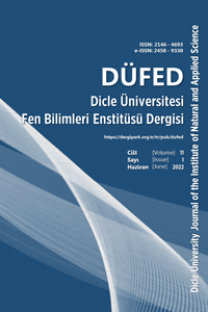Kolzada Brassica napus L. Farklı Memeli Cinsiyet Hormonlarının Fide Gelişimi Üzerine Etkileri
Pamuk, Kanola Brassica napus L. , kışlık ve yazlık olmak üzere iki fizyolojik döneme sahip bir yağ bitkisidir. Kanola tanesinde bulunan %38-50 yağ ve %16-24 protein ile önemli bir yağ bitkisidir.Memeli cinsiyet hormonları, bitkinin farklı fizyolojik sistemlerine etkisinin bulunduğu bilinmektedir. Bununla birlikte farklı cinsiyet hormunuların, kolza bitkisindefide gelişimi parametrelerine muhtemel etkileri üzerine çalışma bulunmamaktadır.Bu araştırmamızın amacı, farklı memeli cinsiyet hormonları ve dozlarının tohum fidelenme ve fide gelişimi üzerineetkileri araştırmaktır. Araştırma, tam şansa bağlı deneme planına göre 3 tekrarlı olarak yürütülmüştür. Bitki materyali olarak kolza Okapi genotipinin tohumları kullanılmıştır. Sterilize edilen kolza tohumları 4 farklı 17 β estradiol, progesteron, testesteron ve östrojen cinsiyet hormonları’ ile oluşturulmuş 5 farklı konsantrasyonunda [ 0 kontrol saf su , 5×10-5, 5×10-4, 5×10-3, 5×10-2 mM ] denenmiştir. Bu araştırmada, kök uzunluğu KU ,sürgün uzunluğu SU ,fide uzunlugu FU , kök yaş ağrlığı KYA , kök kuru ağrlığı KKA , sürgün yaşağrlığı SYA ve sürgün kuru ağrlığı SKA ait veriler elde edilmiştir. İncelenen özellikler üzerine farklı memeli cinsiyet hormonları, dozları ve bunlara ait interaksiyonun tüm parametrelerde çok önemli P
Effects of different mammals sex hormones on development of seedling growth of rapeseed Brassica napus L.
Canola Brassica napusL. is an oil plant having two physiological periods winter and summer . Seed of Canola contains 38-50% oil and 16-24% protein. Mammalian Sex hormones have effects on various physiological systems in plants. However, there has not been adequate studies about the impact of different sex hormones on the Canola seedling parameters. The aim of this study is to investigate the effects of Mammalian sex hormones and their concentration on seedling growth parameters. This research was carried out by randomized complete design in three replications. Seeds of cultivar Okapi were used as the plant material. Sterilized Canola seeds were tested with four mammalian sex hormones with 17 β estradiol, progesterone, testosterone and estrogen 5 different concentrations [ 0 control pure water , 5 × 10-5, 5 × 10-4, 5 × 10-3, 5 × 10-2mM ]. Data for the root length RL and shoot length SL , seedling length SEL , root dry weight RDW , root fresh weight RFW , shoot fresh weight SFW and shoot dry weight SDW were obtained. As a result, effect of different mammalian sex hormones, concentration and their interactions on the traits examined were significant in all parameters P
Keywords:
Canola, seedling growth, mammaliansex hormone,
___
[1] Snowdon R, Lühs W, Friedt W. 2007. Oilseed rape. E. Kole (Ed.), Series Genome Mapping and Molecular Breeding in Plants, Volume 2, Oilseeds. Springer, Berlin, pp. 55–114.[2] Babaoğlu, M., Gürel, E., Özcan, S., 2001. Bitki Biyoteknolojisi I. Doku Kültürü Uygulamaları. Ders Kitabı, Selçuk Üniversitesi Vakfı Yayınları, Konya.
[3] Aydoğdu, M., Boyraz N., 2005. Bitki büyüme düzenleyicileri (Hormon) ve hastalıklara dayanıklılık. Bitkisel Araştırma Dergisi, 1, 35-40.
[4] Kılıç, Y., 2007. Fitohormonların Saplı Meşe (quercus robur l.) 1+0 Yaşlı Fidan Morfolojik Karakterler Üzerine Etkisi.Yüksek lisans tezi, Gazi Üniversitesi Fen Bilimleri Enstitüsü, Ankara
[5] Kumlay, A.M., Eryiğit, T., 2011. Bitkilerde büyüme ve gelişmeyi düzenleyici maddeler: Bitki hormonları. Iğdır Üni. Fen Bilimleri Enst. Der. / Iğdır Univ. J. Inst. Sci. & Tech., 1(2), 47-56.
[6] Taiz, L., Zeiger, E., 2008. Ünite III. Bitki Fizyolojisi, Ed: Türkan, İ., Palme Yayıncılık, Ankara, 309-621.
[7] Milanesi, L., Boland, R., 2004. Presence of estrogen receptor (ER)-like proteins and endogenous ligands for ER in solanaceae. Plant Science, 166, 397-404.
[8] Sarin, R., 2005. Useful metabolites from plant tissue cultures. Biotechnology, 4(2), 79-93.
[9] Milanesi, L., Monje, P., Boland, R., 2001. Presence of estrogens and estrogen Receptor-like proteins in solanum glaucophyllum. Biochemical and Biophysical Research Communications, 289, 1175–1179.
[10]Janeczko, A., Kocurek, M., Marcińska, I., 2012.Mammalian androgen stimulates photosynthesis in drought-stressed soybean. Cent. Eur. J. Biol.,7(5), 902- 909.
[11]Janeczko, A., Budziszewska B., Skoczowski A. Dybala M., 2008. Specific binding sites for progesterone and 17β-estradiol in cells of triticum aestivum L. Acta Biochimica Polonica, 55 (4), 707–711.
[12]Erdal, S., 2012. Alleviation of salt stress in wheat seedlings by mammalian sex hormones..J Sci. Food Agriculture,92, 1411-1416.
[13]Speranza, A., 2010.Into the world of steroids: A biochemical “keep in touch” in plants and animals.Plant Signaling and Behavior, 5(8), 940-943.
[14]Khripach, V., Zhabınskıı, V., Groot, A 2000.Twenty years of brassinosteroids: Steroidal plant hormones warrant better crops for the XXI century. Annals Of Botany 86, 441-447, Doi:10.1006/Anbo.2000.1227,AvailableOnline At http://www.idealibrary.com
[15]Aydın, A., 2014. Bazı ekmeklik buğday genotiplerinin alüminyum stresine toleranslarının belirlenmesi, Yüksek lisans tezi, Atatürk Üniversitesi Fen Bilimleri Enstitüsü, Erzurum
[16]Shore, L. S., Kapulnik, Y., Ben-Dor, B., Fridman, Y,. Wininger, S., Shemesh, M., 1992. Effects of estrone and 17/J-estradioi on vegetative growth of Medicago sativa. Physiologia Plantarum, 84, 217-222.
[17]Bhattacharya, B. and Gupta, K., 1981. Steroid hormone effects on growth and apical dominance of sunflower. Phytochemistry, (20), 989-991
[18]Guan, M., Roddick, J.G., 1988. Epibrassinolideinhibition of development of excised, adventitious and intact roots of tomato (Lycopersicon esculentum): Comparison with the effects of steroidal estrogens. Physiologia Plantarum. 74(4), 720-726.
[19] Dogra, R. and Thukral, A., 1991. Effect of steroid and plant hormones on some germination aspects of Triticum aestivum L. In: New trends in plant physiology Physiology (Eds. K. K. Dhir, I. S. Dua and K. S. Chark), Today and Tomorrow's Printers and Publishers, New Delhi, 65-70.
[20]Janeczko, A. And Skoczowski, A., 2005. Mammalian sex Hormones in plants. Folia Hıstochemıca Et Cytobıologıca, 43(2), 71-79.
[21]Thukral, A.K. and Sharma, D., 1992. Effect of estrogens on the growth of Brassica campestris L. Bionature, (12), 43-46.
- ISSN: 2146-4693
- Yayın Aralığı: Yılda 2 Sayı
- Başlangıç: 2012
- Yayıncı: Dicle Üniversitesi
Sayıdaki Diğer Makaleler
Songül AKIN, Abdurrahman KARA, Muhittin TUTKUN
Kolzada Brassica napus L. Farklı Memeli Cinsiyet Hormonlarının Fide Gelişimi Üzerine Etkileri
Gholamreza JANNATİ, Kamil HALİLOĞLU, Arash Hossein POUR, Parisa BOLOURİ
Hasan KILIÇ, Hüsnü AKTAŞ, Enver KENDAL, Ahmet ALTIKAT, Turan KARAHAN, Vedat KARACA, Çetin MUTLU, Mehmet DUMAN
Ayça Kıyak YILDIRIM, Barış ALTIOKKA
Necla GÜRSOY, Arzu ÜNAL, Ömer Faruk YEŞİL, Semra MALKOÇ, Abdunnasır YILDIZ
